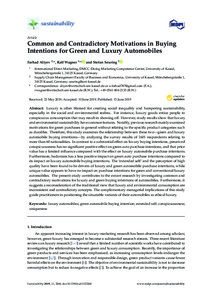Common and Contradictory Motivations in Buying Intentions for Green and Luxury Automobiles
| dc.date.accessioned | 2019-09-10T13:16:15Z | |
| dc.date.available | 2019-09-10T13:16:15Z | |
| dc.date.issued | 2019-06-13 | |
| dc.identifier | doi:10.17170/kobra-20190910675 | |
| dc.identifier.uri | http://hdl.handle.net/123456789/11307 | |
| dc.description.sponsorship | Gefördert durch den Publikationsfonds der Universität Kassel | |
| dc.language.iso | eng | |
| dc.rights | Urheberrechtlich geschützt | |
| dc.rights.uri | https://rightsstatements.org/page/InC/1.0/ | |
| dc.subject | luxury automobiles | eng |
| dc.subject | green automobile buying intention | eng |
| dc.subject | extended self | eng |
| dc.subject | conspicuousness | eng |
| dc.subject | uniqueness | eng |
| dc.subject.ddc | 330 | |
| dc.title | Common and Contradictory Motivations in Buying Intentions for Green and Luxury Automobiles | eng |
| dc.type | Aufsatz | |
| dcterms.abstract | Luxury is often blamed for creating social inequality and hampering sustainability, especially in the social and environmental realms. For instance, luxury goods entice people to conspicuous consumption that may result in showing off. However, study results show that luxury and environmental sustainability have common features. Notably, previous research mainly examined motivations for green purchases in general without relating to the specific product categories such as durables. Therefore, this study examines the relationship between these two—green and luxury automobile buying intentions—by analyzing the survey results of 1601 respondents relating to more than 60 nationalities. In contrast to a substantial effect on luxury buying intentions, perceived conspicuousness has no significant positive effect on green auto purchase intentions, and that price value has a limited influence compared with the effect on luxury automobile purchase intentions. Furthermore, hedonism has a less positive impact on green auto purchase intentions compared to its impact on luxury automobile buying intentions. The ‘extended self’ and the perception of high quality have been found to be drivers of luxury and green automobile purchase intentions, while unique value appears to have no impact on purchase intentions for green and conventional luxury automobiles. The present study contributes to the extant research by investigating common and contradictory motivations for luxury and green buying intentions of automobiles. Furthermore, it suggests a reconsideration of the traditional view that luxury and environmental consumption are inconsistent and contradictory concepts. The complementary managerial implications of this study guide practitioners in positioning the situatable variants of their automobiles as ethical luxury. | eng |
| dcterms.accessRights | open access | |
| dcterms.creator | Aliyev, Farhad | |
| dcterms.creator | Wagner, Ralf | |
| dcterms.creator | Seuring, Stefan | |
| dc.relation.doi | doi:10.3390/su11123268 | |
| dc.type.version | publishedVersion | |
| dcterms.source.identifier | ISSN 2071-1050 | |
| dcterms.source.issue | Issue 12 | |
| dcterms.source.journal | Sustainability | eng |
| dcterms.source.pageinfo | 3268 | |
| dcterms.source.volume | Volume 11 |
Dateien zu dieser Ressource
Das Dokument erscheint in:
-
Artikel [1106]

